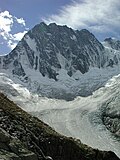| Aiguille Blanche de Peuterey | |
|---|---|
 The north face of the Aiguille Blanche de Peuterey with its three summits, seen from the Pointe Helbronner | |
| Highest point | |
| Elevation | 4,112 m (13,491 ft) |
| Coordinates | 45°49′28″N6°52′58″E / 45.82444°N 6.88278°E |
| Geography | |
| Parent range | Graian Alps |
| Geology | |
| Mountain type | Granite |
| Climbing | |
| First ascent | 31 July 1885 by Henry Seymour King with guides Emile Rey, Ambros Supersaxo and Aloys Anthamatten |
| Easiest route | South-east ridge (D+) |
The Aiguille Blanche de Peuterey (White Needle of Peuterey, 4,112 m) is a mountain of the Mont Blanc massif in Italy. It is considered the most difficult and serious [1] of the alpine 4000-m mountains to climb.
Contents
There are three tops to the mountain:
- Pointe Güssfeldt (4,112 m)
- Pointe Seymour King (4,107 m)
- Pointe Jones (4,104 m)
The three tops are named after Paul Güssfeldt, Henry Seymour King and Humphrey Owen Jones.




